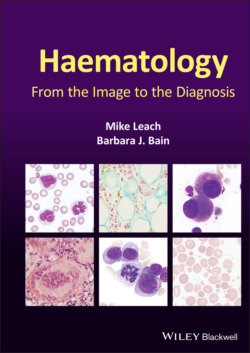Читать книгу Haematology - Barbara J. Bain, Irene Roberts - Страница 21
Оглавление12 eactive mesothelial cells
A 53‐year‐old woman presented with chest pain and dyspnoea. On CT imaging a large mediastinal mass was identified associated with bilateral pleural effusions. On biopsy the mass was shown to be a myeloid sarcoma. There was an associated t(10;11)(p12;q14.2); (PICALM‐MLLT10). The full blood count was normal and a bone marrow aspirate showed no evidence of acute leukaemia. The patient was treated with two cycles of acute myeloid leukaemia induction chemotherapy with marked regression of the mass, but a left pleural effusion, though improved, persisted. A pleural fluid sample was aspirated due to concerns regarding persisting disease. A cytospin preparation is shown above (×50 objective). Note the population of large cells with vacuolated blue cytoplasm and an eccentric nucleus. These features are typical of pleural mesothelial cells; they do not represent a neoplastic population but might be interpreted as such by the inexperienced. In addition, note the small compact lymphoid cells, which are reactive T lymphocytes that are prevalent in reactive effusions (the diagonal line of cells, image right). Morphological and flow cytometry assessment of the fluid specimen identified no precursor myeloid cells. The patient completed a further two cycles of treatment and the effusion fully resolved. She remains well and disease free on follow‐up.
Mesothelial cells are often seen in pleural and ascitic taps. They are shed into the fluid environment when other disease processes cause pleural irritation or interfere with pleural lymphatic drainage. These cells have characteristic morphology as illustrated here, but do not express CD45 or haemopoietic lineage markers. They can on occasion be binucleated (image above ×50) and show significant size variation. They should not be mistaken for carcinoma or other non‐haemopoietic neoplasms. This is another good example of where a careful morphological assessment is necessary and careful correlation with other important points in the history is absolutely essential.
PICALM‐MLLT10 is most often found in T‐acute lymphoblastic leukaemia but also occurs in acute myeloid leukaemia and mixed phenotype acute leukaemia.
MCQ
1 Myeloid sarcoma:Can be the first sign of relapse of acute myeloid leukaemiaCan have a green colourCan be associated with t(8;21)(q22;q22.1)Is common in acute promyelocytic leukaemiaOccurs only at a single siteFor answers and discussion, see page 206.
